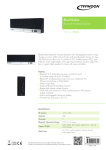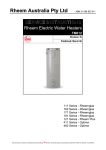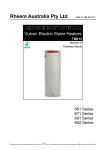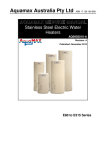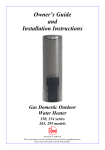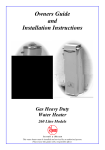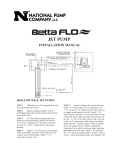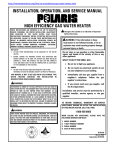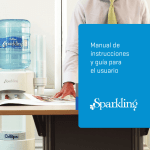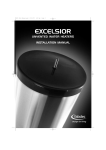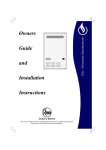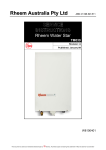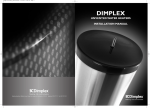Download Rheem 613 Service manual
Transcript
Rheem Australia Pty Ltd Title: - Service Instructions for Rheem Heavy Duty Electric Water Heaters Document control header Document Number: - TM014 Revision Details of change D.O.I. A Service Instructions issued for Rheem Heavy Duty Electric Models 07/02 Rheem Heavy Duty Electric Service Instructions REV: A Date of Issue: 10/7/2002 ELECTRIC RHEEM AUSTRALIA PTY LTD SERVICE INSTRUCTIONS TM014 HEAVY DUTY ELECTRIC WATER HEATERS MODELS 613050 613315 616315 610340 – Storage Tank Rheem Australia Pty Ltd Revision: A TM014 Rheem Heavy Duty Electric Service Instructions REV: A Date of Issue: 10/7/2002 ABN 21 098 823 511 Published: July 2002 1 SAFETY WARNING The purpose of this Service Manual is to provide sufficient information to allow a person with the skills as required by the controlling Regulatory Authorities to carry out effective repairs to a Rheem Heavy Duty Electric Water Heater in the minimum of time. Safety precautions or areas where extra care should be observed when conducting tests outlined in this manual are indicated by print in bold italics and/or a warning symbol. Take care to observe the recommended procedure. Certain diagnostic procedures outlined in these service instructions require “live” testing to be conducted. Personal Protective Equipment (PPE) should be worn when conducting these tests to prevent the risk of electric shock. WARNING: Voltages up to 415 volts AC may be present (Refer to the Rheem Safety Procedure on electrical testing) INTRODUCTION The information provided in these instructions is based on the water heater being installed in accordance with the Installation Instructions provided with each water heater. Should you require further technical advice on a Rheem Heavy Duty Electric Water Heater, contact your nearest Rheem Service Department where all genuine replacement parts are also available. CONTENTS Page 2 3 3 3 4 4 5-6 7-8 8-9 10 - 18 13 - 14 18 19 - 21 22 23 24 25 26 Safety Warning Model Identification Specifications Operation Components And Their Function Preventative Maintenance Wiring Diagrams Common Faults Manifolding Fault Finding Component Tests Electrical Insulation Tests Component Replacement Procedures Exploded View - Three Element Exploded View - Six Element Exploded View – Storage Tank Replacement Parts List Warranty Statement TM014 Rheem Heavy Duty Electric Service Instructions REV: A Date of Issue: 10/7/2002 2 HEATER MODEL IDENTIFICATION All identification numbers are designed to convey detailed information about the water heater to which it is attached. The model number consists of 8 digits. 6 1 6 315 0 8 6 – Heavy Duty 1 – MEPS Compliant 0 – No Heating Units 3 – Three Heating Units 6 – Six Heating Units Rated Capacity in Litres No Reference – System Requirement 0 – Element Not fitted 7 – 3600w 8 – 4800w 9 – 6000w Note: Model number, serial number and date of manufacture should be quoted in all correspondence. SPECIFICATIONS T & PR Maximum Inlet Pressure (kPa) T/stat Valve Setting Rating Without (ºC) With ECV (kPa) ECV Water Connections Series Capacity Rated Capacity (Litres) 613 060 50 1000 680 800 75 RP1¼/32 RP¾/20 613 616 340 315 1000 680 800 75 RP1¼/32 RP¾/20 Tradesperson Adjustable HEAVY DUTY Model 1400 610 340 340 1000 680 800 N/A RP1¼/32 RP¾/20 N/A 1400 Inlet Outlet T&PR T/stat Type Anode Length (mm) 485 OPERATION The 613 and 616 series heavy duty electric water heaters are designed for connection to a 3 phase AC supply incorporating a neutral. On 3 element models the wiring is configured for one element and thermostat combination to be supplied between each active conductor (phase) and neutral. On six element models the wiring is configured for two element and thermostat combinations to be supplied between each active conductor (phase) and neutral. Water temperature is maintained via the thermostat switching the active conductor to an electric immersion element. The thermostat and corresponding element are mounted at intervals up the side of the cylinder. As the water temperature within the cylinder falls the thermostat contacts close suppling power to the element. Each element is switched on sequentially from the bottom up, as cold water enters the cylinder. Once the water temperature reaches the set point of the thermostat, the contacts open cutting power to the corresponding element. A double pole “manual reset” over temperature cut out is incorporated into each thermostat to provide additional protection in the event the controlling thermostat contacts fail. The ECO contacts open between 87ºC and 93ºC. TM014 Rheem Heavy Duty Electric Service Instructions REV: A Date of Issue: 10/7/2002 3 COMPONENTS AND THEIR FUNCTION Temperature and Pressure Relief Valve A valve designed to provide automatic relief by discharging water in case of excessive temperature, pressure or both. Never fit a T&PR Valve with a pressure rating greater than that indicated on the product-rating label. Pressure Limiting Valve (P.L.V.) A valve that controls its outlet pressure to a predetermined limit. Outlet Delivery Tube (Dip Tube) A plastic tube installed in the hot water outlet of the water heater cylinder to conduct water from the highest point to the outlet connection. It also acts as a fitting liner. Diffuser A plastic device installed in the cold water inlet of the water heater cylinder to assist with stratification. It also acts as a fitting liner. Fitting Liner A plastic tube installed in the cold-water inlet of the water heater to provide protection against corrosion through the life of the water heater. Anode (Sacrificial) A metal alloy electrode installed in the water heater cylinder that by galvanic action protects the cylinder from corrosion. Thermostat A device, responsive to temperature, which controls the supply of electrical energy to the element to maintain the stored water at the required temperature. Over Temperature Energy Cutout (E.C.O.) A temperature-sensing device in combination with the thermostat that automatically cuts off the supply of electrical energy to prevent excessive water temperature occurring. This device will not reset automatically but may be manually reset once temperatures have fallen to a safe level. DETERMINE CAUSE OF OPERATION. Heating Unit (Element) A tubular device containing an electric resistance element that converts electrical energy to heat. Standard ratings are 3.6, 4.8 and 6.0kW PREVENTATIVE MAINTENANCE It is suggested for peak performance that the water heater be serviced annually. 1. Check for discharge from the T&PR valve. When the elements are operating a small discharge of water 2. 3. 4. 5. 6. may be evident. Operate the valve-easing lever to ensure the valve opens and resets properly. Always open and close the valve gently. The T& PR valve should be replaced at 5 yearly intervals. Check for leaks at all cylinder fittings. Check for signs of excessive corrosion on the water heater jacket. Isolate power to the water heater and check all electrical connections for signs of overheating due to poor connection. Conduct an electrical insulation test on the water heater. (Refer to page 18) Check for sludge build up and if necessary drain and flush tank. TM014 Rheem Heavy Duty Electric Service Instructions REV: A Date of Issue: 10/7/2002 4 WIRING DIAGRAMS THREE ELEMENT MODELS TM014 Rheem Heavy Duty Electric Service Instructions REV: A Date of Issue: 10/7/2002 5 WIRING DIAGRAMS SIX ELEMENT MODELS TM014 Rheem Heavy Duty Electric Service Instructions REV: A Date of Issue: 10/7/2002 6 COMMON FAULTS When a complaint is lodged about the performance of a hot water system there are a number of causes that should be checked and eliminated. In an attempt to pinpoint the most likely cause it is important to discuss with the customer their reasons for the complaint, the duration of the problem, any change in circumstances or usage and recent weather conditions. This information in conjunction with the following listed common complaints will assist you in locating the most likely cause. All procedures assume there is water flowing through the water heater. Excessive hot water usage The complaints of insufficient hot water and no hot water can on many occasions be attributed to hot water usage exceeding the capacity of the water heater to provide hot water. When first attending a call of this nature it is essential to establish the probable hot water usage by querying the usage habits of the household and compare this with the potential delivery of the model water heater installed. It can then be established if the usage is within or outside the capacity of the model. The areas to look at for excessive usage are: 1. Automatic washing machines. 2. Showers exceeding 12 litres/minute for mixed water and 5 minutes in duration. 3. Two or more showers operating at the same time. 4. Change of occupancy or number of persons increased. 5. High water pressure area. (Excessive pressure relief valve discharge) 6. Plumbing leaks 7. Thermostat temperature setting 8. Crossed connection Discoloured water This may be the result of discoloured water entering from the cold water mains. Check if the cold water is also discoloured. Water hammer A water heater will not cause water hammer, however valves associated with the water heater may be the source of the problem i.e. cold -water stopcock, non-return valve or relief valve. Most water hammer problems are associated with plumbing, hot and cold or appliances i.e. solenoid valves, ballcocks, loose pipes, sharp angles in pipe work, faulty or worn valve parts, loose tap washers or neighbouring equipment. High water pressure areas will have more complaints of this nature and the use of a pressure-limiting valve (PLV) to reduce the household cold -water pressure will usually solve most problems. Hot water plumbing leaks If hot water has not been used for a period of time, feeling the temperature of the hot water line may give an indication of water flow if the pipe is warm. The method of checking for plumbing leaks is: 1. Turn off the stopcock on the cold water supply to the water heater. 2. Open a hot tap to ensure the flow of water stops. This will confirm the stopcock is operating correctly. 3. Turn off the hot tap. 4. Turn on the stopcock to make up the water pressure in the cylinder, and then turn the stopcock off again. 5. Wait approximately 5 minutes then do either of the following: a. With your ear close to the stopcock turn it on slightly and listen for any water passing. If there are no leaks, water should not pass. b. Open a hot tap while listening for any pressure release. If there is a pressure release there will be no leaks in the plumbing system. TM014 Rheem Heavy Duty Electric Service Instructions REV: A Date of Issue: 10/7/2002 7 COMMON FAULTS Mixing or crossed connections If an automatic dishwasher, washing machine, flick mixer tap, tempering valve or thermostatic mixing valve is installed there is always the possibility that the cold water could mix with the hot water through a faulty or incorrectly installed valve. This is referred to as a cross connection. The complaints of insufficient hot water, water too cold or excessive discharge from the pressure relief valve may be attributed to a cross connection. The method of checking for a cross connection is: 1. Turn off the stopcock on the cold water supply to the water heater. 2. Open a hot tap. If water flow is persistent and cold a cross connection exists. Manifolding Very often complaints surrounding insufficient hot water in commercial installations can be attributed to poor manifolding. In order for the water heaters to operate simultaneously the water flow through all the tanks must be the same to ensure the temperature drop is equal across the tanks. In a worst-case scenario it is possible for 2 or 3 of the water heaters in a bank to almost never operate. This results in an overall loss of heat input to the water moving through the building and can be confused as the installation being undersized or a malfunction of the water heaters. The principle of Equa-Flow is to ensure the demand on each water heater in the bank is the same as any other. To achieve this, the following are necessary: 1. The cold water manifold must be designed to balance the flow to each unit i.e. each branch line must be the same diameter and length and be fitted with identical ball or gate valves. 2. The hot water manifold must be designed to balance the flow from each unit i.e. each branch line must be the same diameter and length and be fitted with identical ball or gate valves. TM014 Rheem Heavy Duty Electric Service Instructions REV: A Date of Issue: 10/7/2002 8 COMMON FAULTS Manifolding 3. All the water heaters must be of the same size and capacity. 4. The first heater supplied from the cold (inlet) manifold must be the last heater supplying the hot (outlet) manifold (see examples below). In Line Manifold Back to Back Manifold TM014 Rheem Heavy Duty Electric Service Instructions REV: A Date of Issue: 10/7/2002 Angle Manifold 9 FAULT FINDING Fault Diagnosis Is the complaint for no hot water? YES 1 NO Is the complaint for insufficient hot water? YES 2 YES 3 YES 4 NO Is the complaint for leaking water heater? NO Is the complaint for water too hot ? NO Noisy water heater TM014 Rheem Heavy Duty Electric Service Instructions REV: A Date of Issue: 10/7/2002 10 5 FAULT FINDING No hot water 1 Warning: Terminals may be live, Personal Protective Equipment should be worn. Is 240/415 volts present at the terminal NO block? Test 1 & Test 2 Restore power and advise customer YES YES Is the isolating switch turned off? NO Possible fault in building electrical wiring, continue with diagnosis to confirm water heater is operational NO Is the fuse(s) blown at the switchboard? YES Isolate power and reconnect correctly. Follow flow chart 2 to diagnose any damaged components YES Test 1 Has the heater been connected incorrectly? i.e. Active connected to Neutral terminal NO Test 3, 4 and 5 Isolate power and continue with diagnosis procedure NO Using the procedure on page 18 conduct an electrical insulation test Is the reading below 1 mega-ohm? YES 2 TM014 Rheem Heavy Duty Electric Service Instructions REV: A Date of Issue: 10/7/2002 6 11 FAULT FINDING With multi -element water heaters very often more than one fault may have occurred before the user feels the effect. When servicing a multi-element water heater each thermostat - element combination should be checked to ensure correct operation. In manifolded installations a complaint for insufficient hot water may be due to faults in more than 1 heater or may be a result of poor manifolding. Insufficient Hot Water 2 Test 6 Are the thermostat ECO contacts closed ? NO Is the element installed in the correct orientation? YES Test 7 Are the thermostat contacts closed ? NO NO Install the element correctly and reset the ECO YES Replace thermostat Is the temperature at the T&PR valve at YES Replace thermostat least 6 degrees lower than the thermostat Note: Depending on the stratification some setting? NO YES thermostats may be open and some closed. Ensure the next step is followed to correctly diagnose a faulty thermostat. Slide the thermostat out from under the retaining clamp and allow base to cool YES Test 8 Does the element have the correct resistance? Test 7 Did the thermostat contacts close? NO Replace thermostat NO Replace element Repeat diagnoses for each water heater YES Repeat diagnoses for each thermostat element combination Is more than 1 water heater installed? YES NO TM014 Rheem Heavy Duty Electric Service Instructions REV: A Date of Issue: 10/7/2002 12 2 Water heater electrically ok. Refer to manifolding section COMPONENT TESTING Warning – “Live” equipment Personal Protective Equipment should be worn when conducting these tests. TEST 1 – 3 Element Models TEST 1 – 6 Element Models Using a multimeter on the AC voltage scale, measure between each active and neutral on the terminal block. Normal voltage is 240 volts Warning – “Live” equipment Personal Protective Equipment should be worn when conducting these tests. TEST 2 – 3 Element Models TEST 2 – 6 Element Models Using a multimeter on the AC voltage scale, measure between each active on the terminal block. Normal voltage is 415 volts when connected to a 3-phase supply. TM014 Rheem Heavy Duty Electric Service Instructions REV: A Date of Issue: 10/7/2002 13 COMPONENT TESTING Warning: Ensure power is isolated before conducting these tests TEST 6 TEST 7 Using a multimeter on the x1 resistance scale, Using a multimeter on the x1 resistance scale, measure between terminals 3L and 4L on the measure between terminals 1L and 2T on the thermostat. The reading should be less than 1 ohm thermostat. The reading should be less than 1 ohm. Warning: Ensure power is isolated before conducting these tests TEST 8 TEST 9 Using a multimeter on the x1 resistance scale, measure between terminals 2T and 4L of the Using a megger on the 500V DC setting, measure thermostat. Normal resistance for the heating unit is: between each element wire and earth. 3.6kW: 15 - 17 ohms 4.8kW: 11 - 13 ohms The resistance should be greater than 1 mega ohm 6.0kW: 9 – 11 ohms TM014 Rheem Heavy Duty Electric Service Instructions REV: A Date of Issue: 10/7/2002 14 FAULT FINDING Leaking Water Heater 3 Is the leak from or near the top? NO Is the leak from the electrical access cover? Remove anode and reseal with thread tape YES YES YES NO Is the leak from the T & PR valve? YES Replace water heater NO Is the leak from the anode? Is the leak from the anode cylinder fitting? NO Is the leak from the element barrel fitting? Remove anode cap YES YES NO Remove element and replace gasket YES Is the leak from the T & PR cylinder fitting? NO NO YES YES Is the leak from the inlet cylinder fitting? NO TM014 Rheem Heavy Duty Electric Service Instructions REV: A Date of Issue: 10/7/2002 Check for hot spots on the jacket. If any are detected conduct a pressure test. Replace water heater if pressure will not hold 15 Remove the T & PR valve and reseal with thread tape NO Is the leak from the outlet cylinder fitting? FAULT FINDING Water too hot 4 Does the water temperature at the T&PR valve correspond with or near the thermostat setting? NO Is the thermostat in good contact with the cylinder? YES NO Remove the thermostat and clean any scale from the cylinder wall. Re-tension bracket and refit thermostat YES Explain to customer the reasons for storing water hotter than they may desire i.e. (A) When mixed with cold water more hot water delivery is possible. (B) Prohibit bacteria growth Tempering limiting devices should be suggested as a solution Test 6 Are the thermostat ECO contacts closed? NO Test 7 Are the thermostat contacts closed? Reset the ECO YES Replace thermostat YES Repeat test for each thermostat and element combination NO Is the element installed in the correct orientation? NO YES TM014 Rheem Heavy Duty Electric Service Instructions REV: A Date of Issue: 10/7/2002 16 Refit element correctly Replace thermostat FAULT FINDING Noisy Water Heater 5 NO Is the noise only evident during the heating cycle? Is the noise water hammer? NO Is the noise only evident when water is flowing through the water heater? YES Check for: (A) Mineral build up on the element (B) Mineral or sludge build up in the cylinder (C) Normal noises associated with heating water YES Refer to water hammer causes on page 7, common complaints NO Check all other appliances that can generate noise i.e. washing machine, dishwasher, ball cocks etc. YES Cylinder contracting due to pressure release when hot tap opened. This can also be accompanied by a creaking or cracking sound from the insulation. This noise is normal operation NO Check for a faulty stop cock, non-return valve or T&PR valve YES Check for restrictions in pipe work, faulty valves, loose plumbing or other appliances i.e washing machine or dishwasher. Fit 600kPa pressure limiting valve YES Is the noise a metallic popping sound? NO Is the water pressure more than 80% of the T & PR valve rating? TM014 Rheem Heavy Duty Electric Service Instructions REV: A Date of Issue: 10/7/2002 17 FAULT FINDING Electrical Insulation Test 6 Test 9 Is the reading below 1 mega-ohm? Disconnect the leads to the element from the thermostat and megger between each element lead and earth YES Rewire fuse if necessary NO Disconnect remaining leads from the thermostat and megger between each terminal on the thermostat and earth Replace element Is the reading below 1 mega-ohm? YES Replace thermostat Rewire fuse if necessary NO Check for pinched or damaged wiring touching the water heater chassis ELECTRICAL INSULATION TESTING There are three basic test procedures that should be carried out when the operation and function of a water heater’s electrical system is in doubt. Personal Protective Equipment should be worn when conducting step 1 of this procedure to reduce the risk of electric shock. Refer to Rheem safety procedure on electrical testing. Test No.3 Insulation resistance of the water heater Neutral Circuit. (Reading not to be below 1 mega-ohm). 1. Isolate power to the water heater at the isolation switch. Confirm with multi-meter across each Active and Neutral at the terminal block that voltage is not present. 2. Once satisfied, disconnect the active and neutral wires from the water heater terminal block. 3. Connect megger leads to the neutral of the water heater wiring and earth. 4. Operate megger. A reading above 1 mega-ohm should be obtained. 5. If a reading below 1 mega-ohm is indicated, all component parts will need to be individually tested to locate the fault. Refer to flow diagram 6. Test No.4 Insulation resistance of the water heater Active Circuit. (Reading not to be below 1 mega-ohm). 6. Connect megger leads to the active of the water heater wiring and earth. 7. Operate megger. A reading above 1 mega-ohm should be obtained. 8. If a reading below 1 mega-ohm is indicated, all component parts will need to be individually tested to locate the fault. Refer to flow diagram 6. Test No.5 “Continuity” of water heater electrical circuit. 9. Set megger to resistance scale or multimeter to x1 resistance scale. 10. The reading should correspond with resistances indicated in test 8, page 14. If the reading varies by more than 2 ohms, all electrical component parts will need to be individually tested to locate the fault. 11. Reconnect active cables to ”A” terminal and neutral cable to “N” terminal at heater terminal block. 12. Replace fuse. Note: If continuing with flow chart 2 of diagnostic procedure do not restore power. TM014 Rheem Heavy Duty Electric Service Instructions REV: A Date of Issue: 10/7/2002 18 COMPONENT REPLACEMENT DRAINING THE WATER HEATER (PROCEDURE 1) Elevated temperatures may be present during the draining process. Personal Protective Equipment should be worn to prevent the risk of scalding. Personal Protective Equipment should be worn when conducting step 3 of this procedure to reduce the risk of electric shock. Refer to Rheem Safety Procedure on electrical testing. 1. Isolate the power and water supplies to the water heater. 2. Relieve pressure from the water heater through the T & PR valve or a hot tap. 3. Remove the access cover and confirm with a multi-meter between each Active and Neutral at the terminal block that voltage is not present. 4. Disconnect the cold water supply pipe 5. Fit a drain hose to the cold-water connection and run the other end to a drain or safe location. 6. Open the temperature and pressure relief valve to allow air into the system. TEMPERATURE AND PRESSURE RELIEF VALVE (PROCEDURE 2) Never fit a T&PR valve with a rating higher than that indicated on the water heater rating plate. Do not use reconditioned T&PR valves. 1. Isolate the power and water supplies to the water heater. 2. Relieve pressure from the water heater through the T & PR valve or a hot tap. 3. Remove the drain line from the T&PR valve. 4. Unscrew the T&PR valve and remove. A quantity of hot water will discharge from the tank during this process. Personal Protective Equipment should be worn to prevent scalds or burns. 5. Confirm the replacement T&PR valve is the correct rating and refit using thread tape. 6. Refit the drain line. 7. Close the hot tap and restore water supply. 8. Check T&PR valve thread for leaks. 9. Operate the T&PR valve lever to reset relief drain. 10. Purge air from the system through hot taps. 11. Restore the power supply to the water heater. TM014 Rheem Heavy Duty Electric Service Instructions REV: A Date of Issue: 10/7/2002 19 COMPONENT REPLACEMENT THERMOSTAT (PROCEDURE 3) Personal Protective Equipment should be worn when conducting step 2 of this procedure to reduce the risk of electric shock. Refer to Rheem Safety Procedure on electrical testing. 1. Isolate the power to the water heater and remove access cover. 2. Confirm with multi-meter between each Active and Neutral at the terminal block that voltage is not present. 3. Remove the thermostat protective cover and disconnect the wiring from the thermostat. 4. Slide the thermostat out from under the retaining clamp. Note the current temperature selected. 5. Remove any scale from the cylinder surface 6. Slide the replacement thermostat under the clamp and set temperature to that noted in step 4. Reconnect the wiring as per the circuit diagram (3 element models refer to page 5. 6 element models refer to page 6.) 7. Check water heater internal wiring insulation for cracking. 8. Conduct an electrical insulation test. Refer to page 18. 9. Refit the thermostat protective cover and the access cover. 10. Restore the power supply. DIP TUBE (PROCEDURE 4) 1. Isolate the power and water supplies to the water heater. 2. Relieve pressure from the water heater through the T & PR valve or a hot tap. 3. Disconnect the hot water line from the outlet of the water heater. A quantity of hot water will discharge from the outlet during this process. Personal Protective Equipment should be worn to prevent scalds or burns. 4. Using a flat blade screwdriver gently split the outer rim at the top and bottom of the dip tube face and prise the dip tube out of the cylinder fitting. 5. Fit the replacement dip tube into the cylinder fitting ensuring the flat lines up with the fitting (dip tube facing up) and gently drive the dip tube into the fitting a short distance. 6. Reconnect the plumbing, this will push the dip tube into the correct location. 7. Restore the water supply and purge air from the system through hot taps. 8. Restore the power supply. TM014 Rheem Heavy Duty Electric Service Instructions REV: A Date of Issue: 10/7/2002 20 COMPONENT REPLACEMENT ANODE (PROCEDURE 5) Elevated temperatures may be present during anode removal process. Personal Protective Equipment should be worn to prevent the risk of scalding. 1. Isolate the power and water supplies to the water heater. 2. Relieve pressure from the water heater through the T & PR valve or a hot tap. 3. Remove the anode cap. 4. Using a 27mm tube or socket spanner remove the anode. 5. Apply thread seal tape to replacement anode, refit and tighten. Note: It may be necessary to cut the anode to length prior to fitting. Refer to page 3 for the correct anode length. 6. Restore water supply and check for leaks. 7. Refit the anode cap. 8. Purge air from the system through hot taps and restore the power supply to the water heater. ELEMENT (PROCEDURE 6) Elevated temperatures may be present during element removal process. Personal Protective Equipment should be worn to prevent the risk of scalding. Personal Protective Equipment should be worn when conducting step 2 of this procedure to reduce the risk of electric shock. Refer to Rheem Safety Procedure on electrical testing. Where a fault or leak is traced to the element, the water heater should be drained to prevent damage to flooring or floor coverings by accidental flooding. 1. Isolate power and water supplies and remove the access cover. 2. Confirm with a multi-meter between each Active and Neutral at the terminal block that voltage is not present. 3. Relieve pressure from water heater through the T & PR valve or a hot tap. 4. Drain the water heater. Refer to procedure 1 on page 19. 5. When the water heater is drained, undo the four element screws, removing thermostat clamp first. 6. Withdraw heating unit. Care must be taken to ensure the loop of the heating unit does not catch in the cylinder opening and open out inside the cylinder. NOTE: Do not “cut off” the heating unit and leave a portion inside the cylinder 7. Clean around cylinder fitting, fit gasket to new element and slide heating unit into cylinder taking care that it is in the correct orientation. See heating unit plate for directions. 8. Replace screws and thermostat clamp and tighten. 9. Restore cold water supply and fill the storage tank by gently lifting the easing lever on the T & PR valve until water runs from the drain. 10. Check for water leaks around the element flange. 11. Conduct an electrical insulation test. (Refer to page 18) 12. Replace access cover securely and restore electrical supply. TM014 Rheem Heavy Duty Electric Service Instructions REV: A Date of Issue: 10/7/2002 21 EXPLODED VIEW – THREE ELEMENT MODELS TM014 Rheem Heavy Duty Electric Service Instructions REV: A Date of Issue: 10/7/2002 22 EXPLODED VIEW – SIX ELEMENT MODELS TM014 Rheem Heavy Duty Electric Service Instructions REV: A Date of Issue: 10/7/2002 23 EXPLODED VIEW – STORAGE CYLINDER TM014 Rheem Heavy Duty Electric Service Instructions REV: A Date of Issue: 10/7/2002 24 REPLACEMENT PARTS LIST Item 1 2 3 4 5 6 Description Fitting Liner – Inlet Pipe Seal – Inlet/Outlet Access Cover Adaptor Flange and Pipe Element Screw Element Blanking Plate Element (Incoloy)* - 3.6kW 7 Element (Incoloy)* - 4.8kW Element (Incoloy)* - 6.0kW 8 Thermostat Clamp 9 Element Gasket 10 Thermostat 11 Terminal Block 12 Jacket Bottom 13 T & PR Valve (H.T.E 1000kPa) 14 Fitting Liner – T & PR 15 Pipe Seal – T & PR 16 Jacket Top Anode – Black 17 Anode – Blue Anode – Green 18 Anode Cover 19 Name Band 20 Dip Tube (Outlet) * Mandatory on all heavy duty models TM014 Rheem Heavy Duty Electric Service Instructions REV: A Date of Issue: 10/7/2002 613050 229450 221406-1 103411-1 NF 051404 NF 050254 050255 050256 102501 050704 051314 051510 100526-1 220604 229460 221392-1 100622-1 222023 222033 222037 221720-1 120493 220510 25 613315 229455 221406-1 103511-1 NF 051404 NF 050254 050255 050256 102501 050704 051334 051510 100642-1 220604 229460 221404-1 100647-1 222021 222031 222035 221720-1 120492 220511 616315 229455 221406-1 103512-1 NF 051404 NF 050254 050255 050256 102501 050704 051334 051706 100642-1 220604 229460 221404-1 100647-1 222021 222031 222035 221720-1 120492 220511 610340 229455 221406-1 100766-1 299504 051404 051005 NF NF NF NF 050704 NF NF 100642-1 220604 229460 221404-1 100647-1 221915 221925 222015 221720-1 120491 220511 RHEEM ELECTRIC WATER HEATER WARRANTY - (AUSTRALIA ONLY) Rheem Australia will: a) Repair or, if necessary replace any Rheem water heater; or b) Replace any component (or, if necessary, arrange the installation of a new water heater), which falls within the Warranty Periods specified below, in accordance with and subject to the following table, conditions and exclusions. Installation Models Period Warranty Component and cylinder warranty (from date of installation) New component or water heater free of charge, All installations All models 12 months including labour** Inner cylinder warranty (from date of installation) Years 2 and 3 New water heater free of charge, including labour** Rheemglas New water heater free of charge with installation and Water heater installed in “a single- family Years 4 and 5 labour costs being the responsibility of the owner. domestic premises with a thermostat Years 2 5 New water heater free of charge, including labour** setting below 76ºC” Optima and New water heater free of charge with installation and Heavy Duty Years 6 - 10 labour costs being the responsibility of the owner Water heater installed in any other than “a single- family domestic premises with a thermostat setting below 76ºC” Rheemglas Years 2 and 3 Optima and Heavy Duty Years 2 - 5 New water heater free of charge with installation and labour costs being the responsibility of the owner Notes: ** Refer to item 4 of warranty conditions. Rheem Australia reserves the right to transfer fully functional components from the defective water heater to the replacement water heater if required. WARRANTY CONDITIONS 1. 2. 3. 4. This warranty is applicable only to Rheem water heaters manufactured from 1st January 2001. The water heater must be installed in accordance with the Rheem water heater installation instructions, supplied with the water heater, and in accordance with all relevant statutory and local requirements of the State in 5. which the water heater is to be installed. Where a failed component or water heater is replaced under Warranty, the balance of the original period will remain effective. The replaced part or water heater does not carry a new warranty. Where the water heater is installed outside the boundaries of a 6. metropolitan area as defined by Southcorp or further than 25 km from a regional Southcorp Water Heaters Australia branch office, or an Accredited Service Agent, the cost of transport, insurance and travelling costs between the nearest Southcorp Water Heaters Australia Accredited Service Agent’s premises and the installed site shall be the owner’s responsibility. The warranty only applies to the water heater and original or genuine company component replacement parts and therefore does not cover any plumbing or electrical parts supplied by the installer and not an integral part of the water heater, e.g. pressure limiting valve; isolation valves; nonreturn valves; electrical switches; pumps or fuse. The water heater must be sized to supply the hot water demand in accordance with the guidelines in Rheem water heater literature. WARRANTY EXCLUSIONS REPAIR AND REPLACEMENT WORK WILL BE CARRIED OUT AS SET OUT IN THE RHEEM WATER HEATER WARRANTY ABOVE, BUT THE FOLLOWING EXCLUSIONS MAY CAUSE THE WATER HEATER WARRANTY TO BECOME VOID, AND MAY INCUR A SERVICE CHARGE AND COST OF PARTS. 1. a) b) 2. Accidental damage to the water heater or component including: Acts of God; failure due to misuse; incorrect installation; attempts to repair the water heater other than by a Southcorp Accredited Service Agent or the Southcorp Water Heaters Australia Service Department. Where it is found there is nothing wrong with the water heater; where the complaint is related to excessive discharge from the temperature and pressure relief valve due to high water pressure; where there is no flow of hot water due to faulty plumbing; where water leaks are related to plumbing and not the water heater components; where there is a failure of gas, electricity or water supplies; where the supply of gas, electricity or water does not comply with relevant codes or acts. c) d) e) Where the water heater or water heater component has failed directly or indirectly as a result of: excessive water pressure, temperature and/or thermal input or corrosive atmosphere. Where the water heater is located in a position that does not comply with the Rheem water heater installation instructions or relevant statutory requirements, causing the need for major dismantling or removal of cupboards, doors or walls, or use of special equipment to bring the water heater to floor level. Repairs to the water heater due to scale formation in the waterways when the water heater has been connected to a harmful water supply as outlined in the Owner’s Guide and Installation Instructions booklet. SUBJECT TO ANY STATUTORY PROVISIONS TO THE CONTRARY, THIS WARRANTY EXCLUDES ANY AND ALL CLAIMS FOR DAMAGE TO FURNITURE, WALLS, FOUNDATIONS OR ANY OTHER CONSEQUENTIAL LOSS EITHER DIRECTLY OR INDIRECTLY DUE TO LEAKAGE FROM THE WATER HEATER. In addition to this warranty, the Trade Practices Act 1974 and similar laws in each state and territory provide the owner under certain circumstances with certain minimum statutory rights in relation to your Rheem water heater. This warranty must be read subject to that legislation and nothing in this warranty has the effect of excluding or restricting those rights. Rheem Australia Pty Ltd FOR SERVICE TELEPHONE 131 031 AUSTRALIA 0800 657 335 NEW Zealand A.B.N 21 098 823 511 or refer local Yellow Pages NOTE: Every care has been taken to ensure accuracy in preparation of this publication. No liability can be accepted for any consequences, which may arise as a result of its application. TM014 Rheem Heavy Duty Electric Service Instructions REV: A Date of Issue: 10/7/2002 26



























